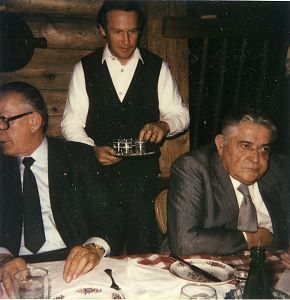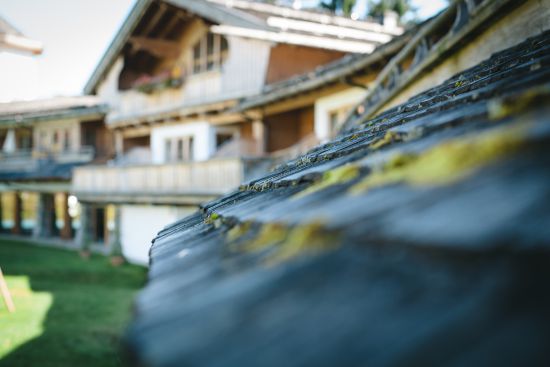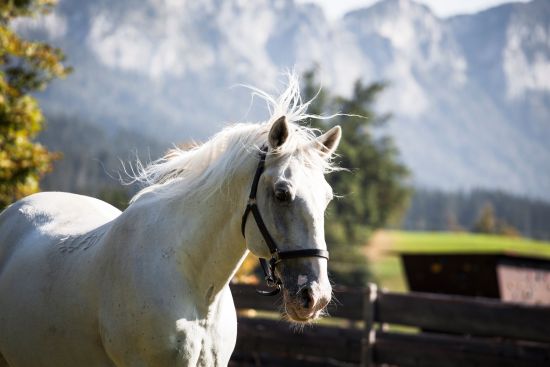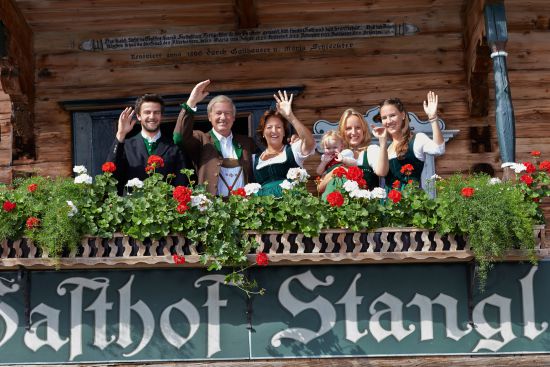Stanglwirt hotline+43 (0)5358 2000Call now
The Balthasar Hauser era

When Maria's brother Balthasar III finishes his catering and hotel training in 1966, he takes over the Stanglwirt. His sister Maria marries and moves to Carinthia, leaving Balthasar without the support of any of his family.
No money, but a lot of ideas
Not even 20 years old and without any capital, Balthasar trusts his intuition and takes the bull by the horns. With no architect and no building material, he starts construction on today's main building in 1968. The timber comes from waste wood around the neighbourhood and the local farmers help in the project.
A tractor bought on credit is the only moving equipment they have. Every brick and every piece of wood has to be carried manually to the second floor.
But it is worth the effort. The new "old building" planned as a hotel for sales reps and travellers passing by has 40 beds and, thanks to the fantastic views towards the Wilder Kaiser, it soon becomes a new attraction.
The Stanglwirt develops

The expansion of the hotel business means that the Stanglwirt's financial turmoil calms down somewhat, so new projects are implemented immediately. Today's "Stanglalm" on the first floor of the inn comes into being and there is investment in the boom sport of tennis. In 1970, he creates three tennis courts across the street, in the shadow of the forest, next to the stream. A major investment that six years later goes down the proverbial drain, as a devastating flood turns the stream into a raging torrent.
Balthasar is in despair and looks to his wife Magdalena for comfort. He had got to know and love the lady from Bavaria who is now his wife at the traditional singers' gathering and it is not long before the happy couple have children.
Soon new and even more beautiful tennis courts are built in an area safe from flood, and two indoor courts are added shortly afterwards. Balthasar seizes an opportunity with both hands and enters into cooperation with a company called Kneissl that finds the tennis courts built to international standards it is looking for at Stanglwirt.
Landscaped roofs

As the perfect way to integrate the two tennis halls into the surrounding area, Balthasar put grass on the rooves and lets his sheep graze there. Although initially greeted with amusement, the idea turns out to be a stroke of genius and brings international recognition to the Stanglwirt.
The Stanglwirt boom continues and the hotel always seems to be too small to keep up with the growing demand. New expansion follows and it is not long before Balthasar realises his next vision.
The Stanglwirt becomes an eco-hotel

Once again Balthasar Hauser is ahead of his time and invests in eco-tourism long before green becomes a trendy word, or energy-efficient passive houses become fashionable. The best spot on the property finally finds its purpose: an eco-hotel will be built there.
It sounds like a great idea, but it is also a massive undertaking as there is nowhere else like it anywhere in Europe. Everywhere else, gigantic concrete constructions are emerging with aluminium or plastic window frames and asbestos used for fire protection. Once again people shake their heads at Balthasar Hauser.
But he is undeterred and chooses lime mortar, timber and clay bricks. The construction becomes a war of nerves, hired consultants throw in the towel, there are continual delays. The redevelopment costs for the shell construction devour huge sums.
Deep in despair, Balthasar Hauser meets a German architect who has made a name for himself by renovating old building structures and using eco-friendly methods of construction. Karl Hermann Schwabe's input means that the eco-hotel can finally be finished.
The European pioneer for eco-hotels

In the middle of the oil crisis in 1980, the Stanglwirt host commissions the first biomass energy plant for a hotel in Europe. But he has to contain his enthusiasm, as the whole of Going is suddenly suffocating under a dense cloud of smoke from the big rough wood chips.
The solution is as ingenious as it is simple: the wood chips are spread out in the indoor riding arena and the horses trample on them, making them smaller.
This reduces the smoke emissions and Going can breathe again.
From the Spanish Riding School to the Stanglwirt

The Stanglwirt has now become a social institution. The eco-hotel, the living traditions of the Hauser family and the innovative ideas of its owner ensure that the hotel is always busy.
But there is not long to wait for the next sensation. At the Austrian TV charity auction "Licht ins Dunkel", Balthasar buys the proud Lipizzaner stallion Pluto Verona for one million Schillings (€ 70,000), suddenly making the Stanglwirt the name on everyone's lips in neighbouring countries as well.
The result is the first private Lipizzaner stud farm in Austria, which attracts many new guests to the Stanglwirt.
The next generation

At this point in time, Balthasar Hauser and his Magdalena are already proud parents.
Son Richard, followed by Maria, Elisabeth and Johannes, are all following in their parents' footsteps and turning the Stanglwirt into an internationally famous five-star green spa resort with farming roots.








